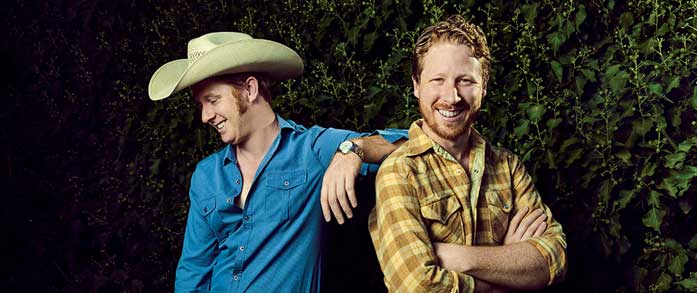
Lachlan and Hamish Davidson – photo by Kane Hibbard
Hamish and Lachlan Davidson come by their kudos naturally. Raised in the rural realms of Western Victoria in Australia, they began playing music at a young age, proving themselves to be adept instrumentalists well-suited to banjo, fiddle, dobro, and mandolin. Winners of five Australian Country Music Awards, and several Bluegrass Championship titles, they’ve become one of their country’s most admired bluegrass bands with eight studio albums — five of which were recorded in Nashville — and 68 original songs (along with an occasional classic country cover), to their collective credit. They’ve also toured extensively throughout Australia, Europe, and North America, while also representing Australia at the IBMAs no less than four times. They’ve also have had the honor of performing with Ralph Stanley, showcasing at Bill Monroe’s childhood home, and on the stage of the Ryman Auditorium.
“We got the thrill of being presenters at the IBMA Awards several years ago, which is still a huge highlight for us,” Lachlan recalls. In addition, the Davidson Brothers have preformed at several of Australia’s leading music festivals, including Port Fairy, Gympie, Tamworth, Woodford, National Folk Festival, Meredith. They’ve also played Bean Blossom, Starvey Creek, and Jerusalem Ridge here in the US, as well as at the Australian Bluegrass Championships.
Both brothers are graduates of the Australian Country Music College, and they made good on their studies in 2003 when they won the State Finals and became runners up in the Grand Final of the National University Band Competition, which also saw Hamish win as Best Overall Musician. Lachlan took honors in the mandolin competition three years in a row, from 2008 – 2010, at the Australian Bluegrass Championships, while Hamish won the Fiddle Championship in 2000, then later, the Banjo Championship in 2009. Together, they were selected as finalists in the Most Outstanding Musicians category of the 2010 Melbourne Prize for Music.
“We both started learning fiddle around 1990, and released our first record, Blue Spruce in 1999,” Lachlan explains. “Our other regular band members include Daniel Watkins, who has worked with us on and off for about thirteen years. We met Daniel at one of our main bluegrass festivals years ago, and found out that he had grown up with similar influences as ours. Once he relocated from Newcastle to Victoria, we started playing together more often. Our regular bass player is Isaac Barter, from Geelong, Victoria, who we first saw playing and jamming at the National Folk Festival in Canberra. We were immediately impressed with his upright bass playing and ability to grasp the feel of bluegrass, so we booked him the first chance we got and then realized he lived close by.”
The brothers describe their sound as both contemporary and traditional bluegrass, with a mix of country, folk, Celtic, and swing thrown in for good measure. They also list such essential influences as Lonesome River Band, Ricky Skaggs, Blue Highway, the Del McCoury Band, Flatt & Scruggs, Bill Monroe, and the Stanley Brothers. “We grew up on Celtic music, with our parents playing bagpipes, so we learned lots of fiddle tunes early on,” Lachlan explains. Later, they had the opportunity to expand their horizons by performing with several of their bluegrass heroes, including Peter Rowan, Don Rigsby, Jim Lauderdale, Mike Compton, and Rob Ickes & Trey Hensley, as well as Andrew Farriss from INXS, and a long list of well known Aussie artists.
“We have a strong following back home, and we’ve been able to tour regionally,” Lachlan notes. “We’ve also been given other great opportunities, like performing on our Australian Country Music Awards show, Golden Guitars, in addition to many TV appearances and showcases at several city events.”
Along the way, the Davidsons have seen bluegrass blossom in their native environs.
“We’ve noticed a real increase in bluegrass popularity in Australia ever since YouTube began giving younger players the opportunity to see and hear from some of the best in the business,” Lachlan adds. “When we started, we didn’t know what most of our heroes looked like, and we had to purchase any bluegrass record we could find, although it was surprisingly easy. We were very lucky that our local market had a used record store run by an old country singer who knew his music history, and always had something great to recommend, from which we’d learn every tune!”
He also offers some reasons why he believes that bluegrass seems to connect with such an expansive international following.
“I think the essence of bluegrass culture is relatable across the world,” Lachlan suggests. “For instance, we have been in jams with bluegrass musicians in Europe who do not speak English, but we all understand the music and the sound. The ability to play acoustic and jam bluegrass anywhere always makes the music exciting and fun. Because we here in Australia grew up so far away from the birthplace of the music, most of us Aussie bluegrassers make the trek to the U.S. to get to as many festivals as they can. That also adds to the excitement of it all.”







